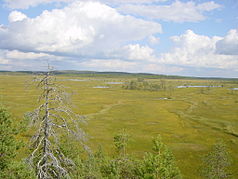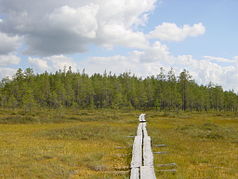Patvinsuo National Park
| Patvinsuo National Park | ||
|---|---|---|
| High moor in the Patvinsuo | ||
|
|
||
| Location: | North Karelia , Finland | |
| Next city: | Lieksa , Ilomantsi | |
| Surface: | 105 km² | |
| Founding: | 1982 | |
| Address: |
www.outdoors.fi/patvinsuonp Offic. National Park website of the Finnish Forest Authority |
|
| The Patvinsuo National Park is located north of Lake Koitere in eastern Finland | ||
| View over the wetlands from the Suomunsaari bird tower | ||
| Lake Suomunjärvi in the north of the national park is surrounded by forest and reeds, ... | ||
| ... but also surrounded by natural sandy beaches | ||
| On the designated paths, wooden bridges make it easier to get around the moor | ||
Patvinsuo is in the eastern Finland in the communities Lieksa and Ilomantsi situated National Park whose core through the same, between the lakes Suomunjärvi and Koitere located sump is formed. The national park, founded in 1982, primarily serves to preserve and research the natural swampy habitat, but also includes old forests and lakes with natural sandy beaches. At 105 km², Patvinsuo is the largest national park in the southern half of Finland.
nature
The nature of southern Finland differs significantly from that of the north of the country. The Patvinsuo National Park is located in the upheaval zone of these areas and has characteristic features of both habitats.
Moors
The majority of the area of the national park is occupied by moors . These consist partly of the typical Southern torfreichen bogs , partly from the northern intersected by Moor strands Aapamooren .
The raised bogs of the Patvinsuo are usually so-called Kermimoore, in which the kermis, i.e. the peat moss shields, run in narrow strips around swampy areas. The vegetation is dominated by cotton grass , multberries and cranberries . The central part of the extensive Patvinsuo consists of aapa bogs, which receive nutrients from the surrounding forest areas during the annual snowmelt and can thus accommodate a more diverse vegetation than the raised bog areas.
Lakes and rivers
The Patvinsuo area borders on Lake Koitere to the north. Immediately after the last ice age , the Patvinsuo was part of the lake. By slowly lifting the continental masses freed from the ice, the Patvinsuo rose from the lake and sunk into the marsh. What remained was a largely sandy subsoil and some lakes surrounded by sandy banks, the largest of which is Suomunjärvi in the north of the national park.
The moor is also crossed by several slow-flowing rivers, the largest of which is the Nälmänjoki, which flows from the rocky lake Nälmänjärvi into the Koitere. Today 20 to 30 Canadian beavers live in the numerous tributaries , whose ancestors were a pair of beavers abandoned in Nälmänjoki in 1945.
Woods
The national park includes forests of various ages, some of them untouched virgin forests. On the hill Hietavaara there are trees up to 200 years old, whose scars show that they have survived several large forest fires. Large parts of the park's forests are also young, former commercial forests .
The forests are home to the heraldic animal of the park, the brown bear , whose tracks can be found in many places if you rarely come across the shy and nocturnal animal in nature. Furthermore, wolves , lynx and wolverines as well as numerous moose are at home in the forests of Patvinsuo . The endangered European flying squirrels and numerous species of birds such as the three-toed woodpecker and the miniature flycatcher live in the tops of the old trees .
Maintenance of the national park
The Patvinsuo is under the administration of the Finnish state forest authority Metsähallitus . In addition to the maintenance of the facilities for visitors to the national park, the tasks of the authority also include the return of the site, which was placed under protection in 1982, to a condition that corresponds as closely as possible to its original condition and provides an appropriate habitat for the species typical of the landscape.
For this purpose, drainage ditches previously dug in the wetlands are being removed. In the forests, the development of rotten wood on the ground is accelerated, on the one hand trees are felled, on the other hand the bark of trees is planed off in a ring so that the corresponding trees die in an upright position.
The natural cycle of the forest also includes regular forest fires , which have recently become rare in Finland due to the strict fire control and defense. The species that currently specialize in burned down forests, including numerous beetles , are therefore under pressure in Finland or have already disappeared. In the Patvinsuo National Park, therefore, since 1989, controlled areas of forest have been burned to simulate the effects of forest fires caused by lightning strikes.
research
In the north of the national park, the area of Lake Hietajärvi is one of four Finnish research areas within the framework of the international cooperative program for the integrated monitoring of the effects of air pollutants on ecosystems under the auspices of the United Nations Economic Commission for Europe . It is one of two Finnish areas that are under intensive surveillance. In the designated area, visitors are only allowed to use the designated paths all year round.
Visitors
Visitors to the national park are generally allowed to move freely in it. Exceptions are certain protection zones, in which the designated paths must not be left during the bird breeding season, as well as the research area Hietajärvi, in which this restriction applies all year round, apart from the harvest time of the multberry at the end of July.
There are around 80 kilometers of hiking trails in the national park. These are also easily accessible in the moor areas thanks to well-tended footpaths. Camping is only allowed at the seven separate campsites. These have dry toilets and fire pits, where the wood provided on site by the park administration can be used to make a campfire if there is not a risk of forest fire.
Other permitted activities include swimming, rowing, fishing - but only with a fee-based fishing permit - as well as picking berries and mushrooms.
history
The area around what is now the Patvinsuo National Park was used as a hunting area centuries ago. The area around Suomunjärvi was settled in the 17th century. Agriculture in the true sense of the word could hardly be practiced in the marshland, the residents primarily harvested marsh meadow grass for use as hay . In the course of time, arable land was only obtained to a small extent by slash and burn .
During the Second World War , the Patvinsuo was used intensively for the production of charcoal in order to make up for the lack of fuel caused by the war. The numerous dry trees in the moorland that died while standing served as raw material. The area was also repeatedly targeted by Russian partisan attacks during the war .
literature
- Markku Lappalainen: Ulapalta paljakalle. Suomen kansallispuistot . Gummerus, Jyväskylä 2001, ISBN 952-446-265-6 .






